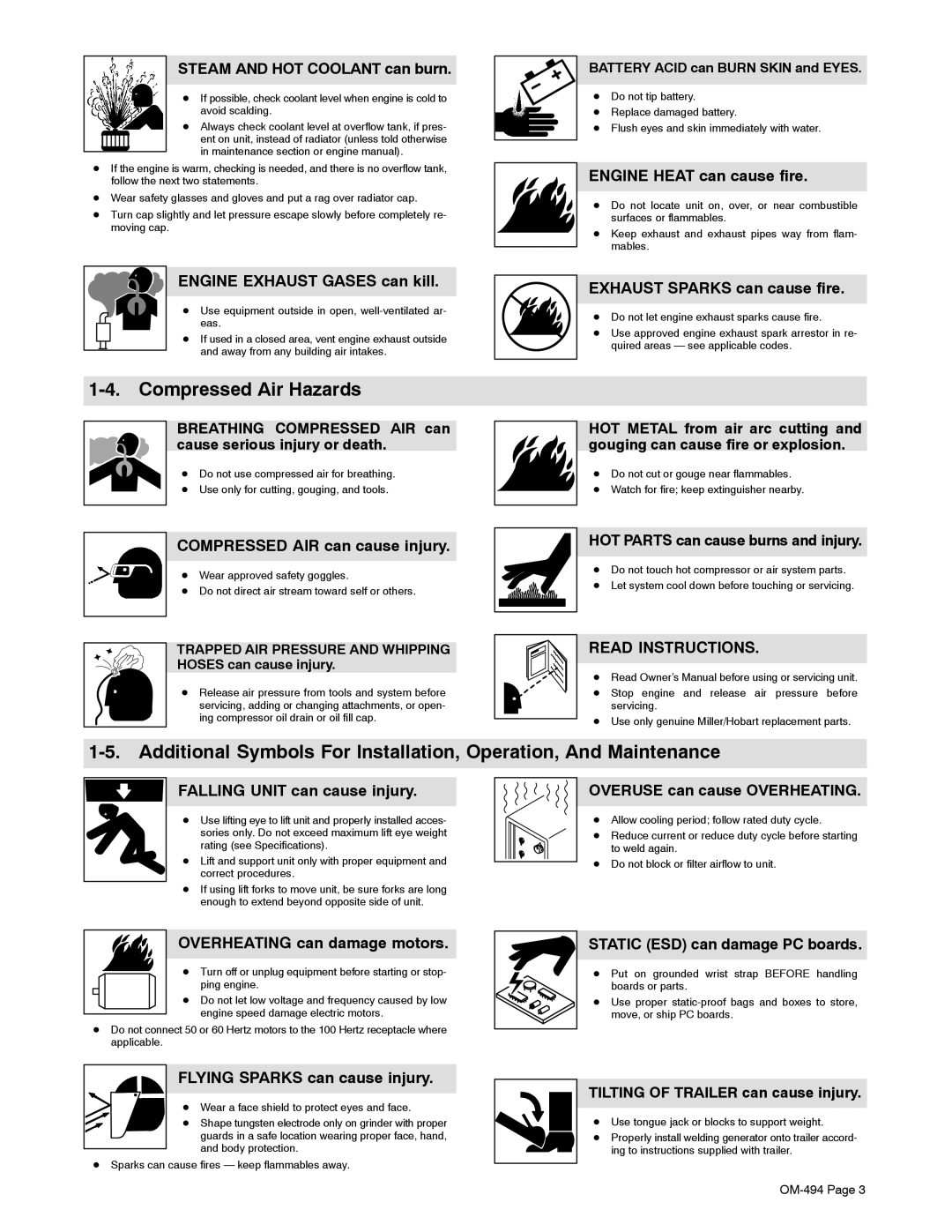
STEAM AND HOT COOLANT can burn.
DIf possible, check coolant level when engine is cold to avoid scalding.
D Always check coolant level at overflow tank, if pres- ent on unit, instead of radiator (unless told otherwise in maintenance section or engine manual).
DIf the engine is warm, checking is needed, and there is no overflow tank, follow the next two statements.
DWear safety glasses and gloves and put a rag over radiator cap.
DTurn cap slightly and let pressure escape slowly before completely re- moving cap.
ENGINE EXHAUST GASES can kill.
D Use equipment outside in open,
DIf used in a closed area, vent engine exhaust outside and away from any building air intakes.
BATTERY ACID can BURN SKIN and EYES.
DDo not tip battery.
DReplace damaged battery.
DFlush eyes and skin immediately with water.
ENGINE HEAT can cause fire.
DDo not locate unit on, over, or near combustible surfaces or flammables.
DKeep exhaust and exhaust pipes way from flam- mables.
EXHAUST SPARKS can cause fire.
DDo not let engine exhaust sparks cause fire.
DUse approved engine exhaust spark arrestor in re- quired areas — see applicable codes.
1-4. Compressed Air Hazards
BREATHING COMPRESSED AIR can cause serious injury or death.
DDo not use compressed air for breathing.
DUse only for cutting, gouging, and tools.
HOT METAL from air arc cutting and gouging can cause fire or explosion.
DDo not cut or gouge near flammables.
DWatch for fire; keep extinguisher nearby.
COMPRESSED AIR can cause injury.
DWear approved safety goggles.
DDo not direct air stream toward self or others.
HOT PARTS can cause burns and injury.
DDo not touch hot compressor or air system parts.
DLet system cool down before touching or servicing.
TRAPPED AIR PRESSURE AND WHIPPING HOSES can cause injury.
DRelease air pressure from tools and system before servicing, adding or changing attachments, or open- ing compressor oil drain or oil fill cap.
READ INSTRUCTIONS.
DRead Owner’s Manual before using or servicing unit.
DStop engine and release air pressure before servicing.
DUse only genuine Miller/Hobart replacement parts.
FALLING UNIT can cause injury.
DUse lifting eye to lift unit and properly installed acces- sories only. Do not exceed maximum lift eye weight rating (see Specifications).
DLift and support unit only with proper equipment and correct procedures.
DIf using lift forks to move unit, be sure forks are long enough to extend beyond opposite side of unit.
OVERUSE can cause OVERHEATING.
DAllow cooling period; follow rated duty cycle.
DReduce current or reduce duty cycle before starting to weld again.
DDo not block or filter airflow to unit.
OVERHEATING can damage motors.
DTurn off or unplug equipment before starting or stop- ping engine.
DDo not let low voltage and frequency caused by low engine speed damage electric motors.
DDo not connect 50 or 60 Hertz motors to the 100 Hertz receptacle where applicable.
FLYING SPARKS can cause injury.
DWear a face shield to protect eyes and face.
D Shape tungsten electrode only on grinder with proper guards in a safe location wearing proper face, hand, and body protection.
DSparks can cause fires — keep flammables away.
STATIC (ESD) can damage PC boards.
DPut on grounded wrist strap BEFORE handling boards or parts.
DUse proper
TILTING OF TRAILER can cause injury.
DUse tongue jack or blocks to support weight.
DProperly install welding generator onto trailer accord- ing to instructions supplied with trailer.
